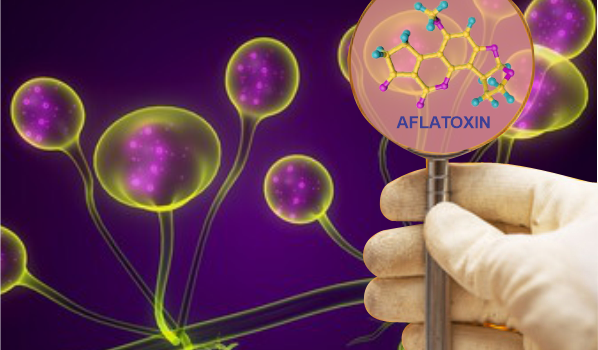Toxin management: Put a stop to hidden threat in feed
Synopsis: The article suggests how toxins in feed can cause hindrance to the farm profit and by adopting appropriate preventive measures one can put halt to the negative consequences of these toxins.
Toxin: A hurdle in way of farm profitability
 Toxin word is derived from Latin word “Toxicum” means poison. Any small molecule, peptide or protein which has potential to alter the normal metabolism of host cells with deleterious effect comes under toxin. Poultry feed provides all the vital nutrients to birds so that their body functions well and their health remains in great condition. A healthy feed not only keeps them away from diseases but also enhances the quality of the produce derived from them. But, poultry feed also has the potential to contain a wide range of contaminants including biological, chemical (including radiological), or physical. Contaminants maybe introduced into feed from either natural sources (Mycotoxins) or potentially introduced during the manufacturing process. These toxic compounds present may exert anti-nutritional effects, reduce reproductive performance, decreases body weight, causes mortality and adversely affect health of farm birds.
Toxin word is derived from Latin word “Toxicum” means poison. Any small molecule, peptide or protein which has potential to alter the normal metabolism of host cells with deleterious effect comes under toxin. Poultry feed provides all the vital nutrients to birds so that their body functions well and their health remains in great condition. A healthy feed not only keeps them away from diseases but also enhances the quality of the produce derived from them. But, poultry feed also has the potential to contain a wide range of contaminants including biological, chemical (including radiological), or physical. Contaminants maybe introduced into feed from either natural sources (Mycotoxins) or potentially introduced during the manufacturing process. These toxic compounds present may exert anti-nutritional effects, reduce reproductive performance, decreases body weight, causes mortality and adversely affect health of farm birds.
Endotoxins: A Hidden threat in feed
Refers specifically to the lipopolysaccharide (LPS) located in the outer membrane of Gram-negative bacteria. LPS are released into the environment when the bacteria multiply or when their cell membranes rupture through bacterial lysis and thus causes inflammatory immune response in the poultry which comes at the expense of the production performance. Gastrointestinal tract is the main target site, where they can be transferred from the lumen into the bloodstream, causing endotoxemia. The permeability of the gut is tightly controlled by enterocytes which are connected by tight junction proteins, this keeps endotoxins on the luminal side. But when dysbiosis occurs, several external factors (Heat stress, sudden changes in diet, pathogen, low ruminal pH and high osmolality etc.) increases gut permeability and excessive triggering of the immune system. This promotes leakage of endotoxins into the bloodstream, can result in septic shock and even death. The translocation of endotoxins into the blood steam can also take place across the rumen epithelium, which is a multi-layer structure and is covered by keratinized cells. Endotoxins has cosmopolitan distribution: in the air, the water, soil and in the gastrointestinal tract of poultry. Protecting all livestock from their toxic effects should be a priority for everyone from feed to farm. Like providing the products which are adequately heat processed, the risks of contamination with E. coli, Salmonella spp. and Campylobacter spp. are likely to be controlled.
Mycotoxins are cosmopolitan menace to farmers
Mycotoxins are low molecular weight secondary metabolites produced by certain strains of filamentous fungi such as Aspergillus, Penicillium and Fusarium, which invade crops in the field and may grow on foods during storage under favorable conditions of temperature and humidity.
Factors affecting development of fungi and mycotoxin production are:
- Physical factors: Humidity, temperature, microflora zones and physical integrity of the grains
- Chemical factors: pH, composition of the substrate and mineral nutrients
- Biological factors: Presence of insects and specific strains
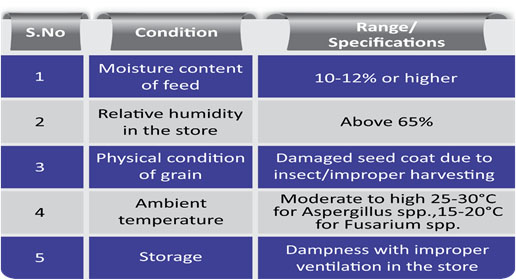
Aflatoxins are highly toxic compounds. The liver is the main organ affected, followed by the kidneys. They cause hepatic changes leading to serious liver damage characterized by hemorrhages, cirrhosis and fatty degeneration of the liver. Aflatoxins are absorbed from the gut and are transported to the liver where they are metabolized. Among the naturally occurring aflatoxins, AFB1 is the most acutely toxic followed by AFG1, AFB2 and AFG2.
T-2 toxin can cause caustic injury to the mucosa, destroying cells on the tips of villi, and affect rapidly dividing crypt epithelium.
Zearalenone affects the reproductive system of birds. This toxin is responsible for estrogenic syndrome that affects any stage of reproduction. Zearalenone is found to be relatively stable in heat conditions. While the mold can withstand high heat conditions, growth most efficiently in moist and cooler conditions.
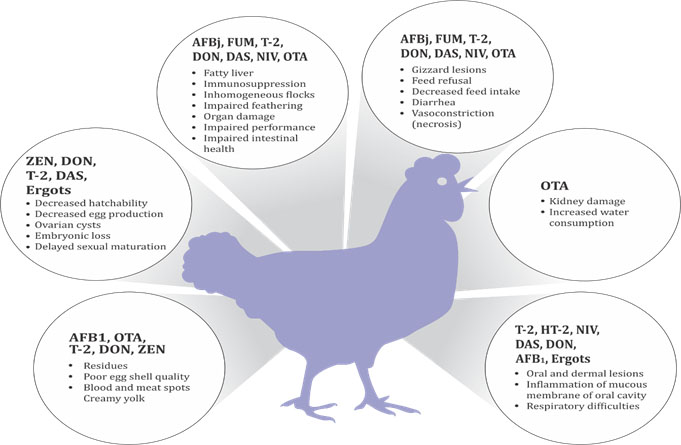
Co-contamination of Mycotoxins is major risk as synergistic interactions exaggerate toxicity symptoms. A per recent survey conducted by renowned Indian company it shows that from the total samples analyzed, 86% samples were contaminated with more than one mycotoxin and 24% samples were contaminated with more than four different mycotoxins and corn gluten meal is highly contaminated with all mycotoxins.
Role of Toxin binder
Refers to a substance added to feed in minute quantities that is able to neutralize or immobilize harmful chemicals, mycotoxins or endotoxins (lipopolysaccharides) within a gastrointestinal tract, thus avoiding negative consequences. They prevent toxins from entering the blood stream, where they can cause serious harm to poultry birds. They help by reducing bioavailability of toxins in the diet and prevent them from being absorbed through the gut and entering the blood circulation. They improve overall poultry health and also reduce risk of human exposure.
Aluminosilicates are clay minerals composed of aluminium, silicon, and oxygen, plus countercations. Natural soil minerals (Zeolite and bentonite) are crystalline alumino-silicates characterized by their ablity to exchange cations without major changes in structure. Natural clays can adsorb toxic products of digestion and decrease the accumulation of toxic substance, thus decreasing the incidence of internal disorders. Natural soil minerals may stimulate the lining of the intestinal tract that increases the production of antibodies, which could then inhibit the onset of enteritis. HSCAS and Montmorillonite clay are most studied binder, on many species including poultry.
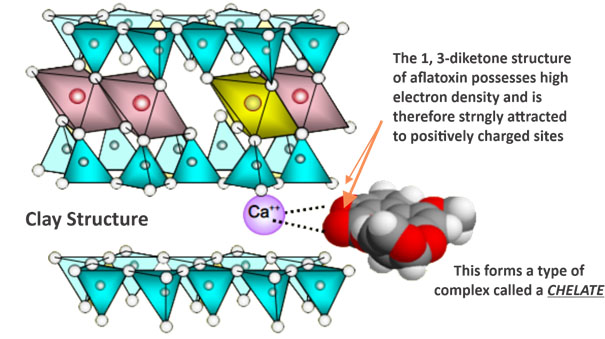
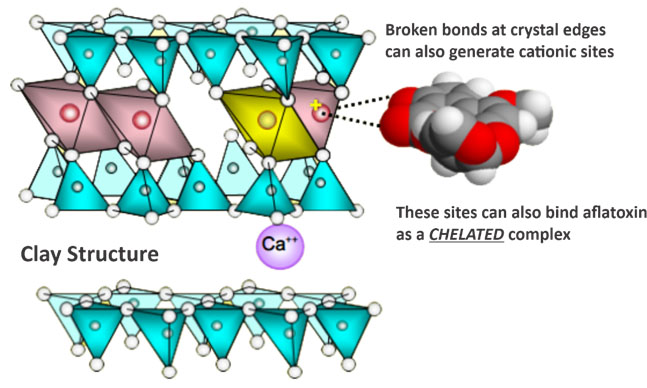
Activated charcoal is a universal toxin binder. It is a general adsorptive material with a large surface area and excellent adsorptive capacity and recommended for various digestive toxicities. Many toxins are positively charged, and a binder that is negatively charged like charcoal will be attracted to them, and able to adsorb many of them. The Activated charcoal and the toxin are then excreted in the feces if it is part of food ingestion, or if it is cycling through the enterohepatic circulation with the bile. Activated charcoal is not absorbed by the body. Therefore, if it binds a toxin in the intestinal tract, it and the toxin end up leaving the body.
Organic acids controls and prevents fungal growth by lowering pH of feed. They also enhances digestibility of nutrients by lowering pH of gut. This aids digestibility of proteins and thus increases availability of amino acids.
Cinnamaldehyde inactivates S.enteridis, C.jejuni & reduces colonization, while Carvacrol has action against C.perfringens & E.coli. They down-regulate toxin producting genes, modulates transcriptional repressor and modifies bacterial membranes, thus arrest bacterial multiplication.
Yeast cell walls are potential mycotoxin binders, besides having nutritional value. Using only yeast cell walls instead of whole cells, the adsorption of mycotoxins can be enhanced. The beta-d-glucan fraction of the yeast cell wall is directly involved in the binding process with Fusarium mycotoxins as zearalenone, and the structural organization of beta-d-glucan modulates the binding strength. It appears that carbohydrate components are common sites for binding, with different toxins having different binding sites. Microbial cell walls can be used to alleviate the harmful effects of mycotoxins in contaminated feeds. Adsorbents derived from cell wall of the yeast Saccharomyces cerevisiae and lactic acid bacteria have shown to bind Fusarium toxins and help reduce the toxic effects in poultry. Complex carbohydrates in bacterium and yeast cell walls such as β-glucans and mannans have been demonstrated to adsorb mycotoxins (Zearalenone, Ochratoxin A (OTA), a toxic secondary fungal metabolite that widely takes place in various kinds of foodstuffs and feeds.
Herbs like Azadirachta indica has potent antifungal and antibacterial action that fights with the endotoxins producing bacteria. It is effective against a wide spectrum of insects, fungi and viruses, which reveals its great potential as a possible biological control of fungi and mycotoxins.
Humic acid acts as natural chelator of toxin or heavy metals & push them out of the body. The supplementation of Humic acid also enhances the humoral immunity by counteracting the aflatoxin contamination.
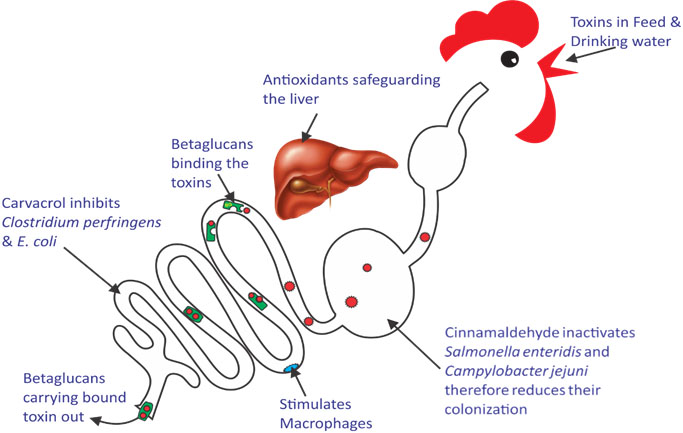
At last, feed contamination by fungi can be a plight for feed security. Under the unfavorable condition of temperature and humidity, the occurrence of mycotoxins including aflatoxins has become overbearing. Thus, there is a need for understanding multiple effects of mycotoxins, their trans-conversions and masked mycotoxins. The advances in Activated charcoal, aluminosilicates, yeast, yeast-based products, organic acids and various herbal extracts and their combinations have been quite successful to decrease the harmful effects of mycotoxins.
More details can be reached at www.nutricare.in
Previous article by author(s): Holistic Approach Towards Gut Health In Poultry



